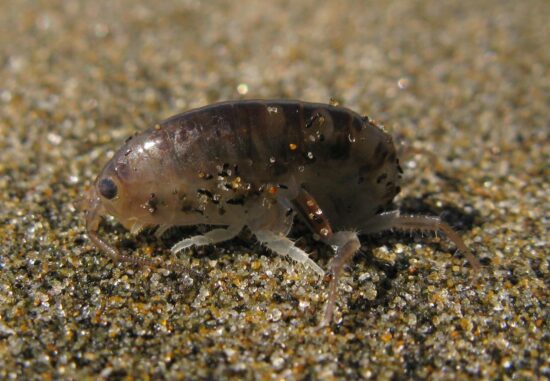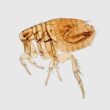Planning a beach trip? You’ve probably heard warnings about sand fleas ruining your fun in the sun. But here’s something that might surprise you: most people don’t actually know what sand fleas really are. The truth is pretty confusing, and getting it wrong could mean treating your bites the wrong way.
Let’s clear up the mystery once and for all so you can enjoy your beach time without worry.
What Are Sand Fleas? The Surprising Truth
Here’s where things get tricky. When people talk about “sand fleas,” they’re usually referring to one of three completely different creatures. Each one looks different and needs different treatment if they bite you.
Beach hoppers are the real sand fleas. These little guys are actually more like tiny shrimp than fleas. They hop around the beach but don’t bite people at all. So if something bit you at the beach, it probably wasn’t one of these.
Sand flies are the tiny flying bugs that cause most sand flea bites. These are what’s usually bothering you during beach visits. They’re so small you can barely see them, but their bites pack a punch.
Chigoe fleas are the dangerous ones, but they only live in tropical places like parts of South America, Africa, and the Caribbean. These actually burrow into your skin and cause serious problems that need medical attention right away.
Most beach visitors in the United States are dealing with sand flies, not actual sand fleas. But knowing the difference matters because the treatment changes depending on what bit you.
What Each Type Looks Like
Beach Hoppers (The Real Sand Fleas)
Beach hoppers look like tiny gray or brown shrimp about the size of your fingernail. They have long back legs that help them jump really well, kind of like miniature kangaroos. You’ll see them hopping around wet sand near the water, especially at night.
These little crustaceans have two long feelers sticking out from their heads and small black eyes on top. During the day, they bury themselves in the sand to stay cool and moist. When the sun goes down, they come out to look for food like bits of seaweed and other ocean debris.
Remember, these guys don’t bite humans. If you see them hopping around, you can watch them without worrying about getting bitten.
Sand Flies (The Real Biters)
Sand flies are incredibly tiny, about the size of the period at the end of this sentence. They have small hairy wings that make them look a bit like tiny moths. Most people can’t see them clearly without looking very closely.
These little pests are most active when the sun is going down or coming up. They hide during the hot middle part of the day and come out when it’s cooler. You might not even see them biting you, but you’ll definitely feel the results later.
Sand flies are the real culprits behind most sand flea bites. They’re found all over coastal areas and can make beach visits pretty miserable if you’re not prepared.
Chigoe Fleas (The Dangerous Ones)
Chigoe fleas are so small you can’t really see them with your eyes alone. They’re only about 1 millimeter long, which makes them the smallest fleas in the world. These are the ones that actually burrow into your skin.
The scary part about chigoe fleas is what they do once they get under your skin. The female flea grows bigger and bigger as she feeds and lays eggs, eventually becoming about the size of a pea. This creates a painful, infected bump that can cause serious health problems.
Luckily, you only need to worry about these if you’re traveling to tropical areas. They’re not found on regular beaches in places like California, Florida, or the East Coast.
What the Bites Look Like
Sand Fly Bites
Sand flea bites from sand flies show up as small red bumps that itch like crazy. They often appear in groups or lines, usually on your feet, ankles, and lower legs where the bugs can easily reach your skin.
The bites start itching within a few hours and can keep bothering you for up to two weeks. They look similar to mosquito bites but tend to be smaller and often come in clusters. The itching can be so intense that it’s hard to resist scratching, but that only makes things worse.
Some people have stronger reactions than others. If you’re sensitive to bug bites, you might see more swelling and redness around each bite. The bumps might also take longer to go away.
Chigoe Flea Bites
Chigoe flea bites start looking like tiny red spots with a dark dot in the center. As the flea grows under your skin, the bite turns into a white bump with a black center. Eventually, it becomes a painful, pea-sized lump that can get infected.
These bites are serious business. They don’t just itch; they hurt and can lead to dangerous infections if not treated by a doctor. The skin around the bite often becomes red, swollen, and warm to the touch.
If you think you might have chigoe flea bites, don’t try to treat them yourself. Get medical help right away, especially if you’ve been traveling in tropical areas.
How to Treat the Bites
Treating Sand Fly Bites
The good news about sand flea bites from sand flies is that you can treat them at home with things you probably already have. Here’s what works best:
Clean the area first by washing the bites with soap and water. This helps prevent infection and removes any dirt or sand that might make the itching worse.
Apply something cold like an ice pack wrapped in a towel or a cold, wet cloth. This helps reduce swelling and numbs the itching for a while. Keep it on for about 10 minutes at a time.
Use anti-itch treatments to get relief. Hydrocortisone cream works well for reducing inflammation and itching. Calamine lotion is another good choice that dries out the bites and provides cooling relief. You can find both of these at any drugstore.
Take antihistamines if the itching is really bad. Pills like Benadryl or Zyrtec can help reduce your body’s reaction to the bites. These work especially well if you have lots of bites or if you’re someone who reacts strongly to bug bites.
Try home remedies for extra relief. Aloe vera gel feels cool and soothing on irritated skin. You can also try taking an oatmeal bath by adding plain oatmeal to cool bathwater and soaking for 15-20 minutes.
The most important thing is to avoid scratching the bites. This is really hard to do because they itch so much, but scratching can lead to infection and makes the healing take much longer.
Treating Chigoe Flea Bites
Don’t try to treat chigoe flea bites yourself. These need professional medical care right away. A doctor or nurse will need to carefully remove the flea from your skin using sterile tools.
You’ll probably need antibiotics to prevent or treat infection. The doctor might also recommend a tetanus shot if yours isn’t up to date, since these bites can let dangerous bacteria into your body.
After the flea is removed, you’ll need to keep the area very clean and watch for signs of infection like increased redness, warmth, or pus.
When to See a Doctor
Most sand flea bites can be treated at home, but sometimes you need professional help. See a doctor if:
The bites are getting worse instead of better after two or three days. They should start feeling better and looking less red within this time.
You see signs of infection like pus, red streaks going away from the bite, or the area feeling hot and swollen.
You develop a fever, feel sick, or have swollen lymph nodes after getting bitten.
You have trouble breathing, get hives all over your body, or have other signs of a serious allergic reaction.
You think you might have chigoe flea bites, especially if you’ve been traveling in tropical areas.
How to Prevent Getting Bitten
The best way to deal with sand flea bites is to avoid getting them in the first place. Here are the most effective ways to protect yourself:
Use insect repellent with DEET. Products with 20-30% DEET work best against sand flies. Spray it on all exposed skin, paying special attention to your feet and ankles where bites happen most often. Remember to reapply every few hours, especially if you’re swimming or sweating a lot.
Time your beach visits to avoid the worst bug activity. Sand flies are most active early in the morning and at sunset. If you can, plan your beach time for the middle of the day when it’s sunny and hot. The bugs don’t like being out in bright sunlight and high heat.
Wear protective clothing when you can. Closed-toe shoes help protect your feet, which are the most common target for sand flea bites. Light-colored, long-sleeved shirts and pants provide more coverage during times when bugs are active.
Create barriers between you and the sand. Use beach chairs instead of sitting directly on the sand. If you want to lie down, use a thick towel or beach mat that covers your whole body. This makes it harder for bugs to reach your skin.
Stay away from buggy areas. Sand flies like to hang out near piles of seaweed, in shady spots, and around areas where the sand stays damp. Stick to sunny, open areas of the beach when possible.
Try natural alternatives if you prefer to avoid chemical repellents. Coconut oil can create a barrier that makes it harder for bugs to bite through. Essential oil sprays made with citronella, eucalyptus, or peppermint may also help keep sand flies away, though they’re usually not as effective as DEET.
Special Tips for Tropical Travel
If you’re heading to tropical areas where chigoe fleas live, take extra precautions:
Research your destination to find out if chigoe fleas are a problem in the areas you’ll be visiting. Your doctor or a travel clinic can give you specific advice.
Never walk barefoot on beaches, dirt roads, or in rural areas. Always wear closed shoes, even if it’s hot.
Pack strong insect repellent and use it regularly, not just at the beach but anytime you’re outdoors.
The Bottom Line
Most people who think they have sand flea bites actually got bitten by sand flies, not sand fleas. True sand fleas are those little hopping crustaceans that don’t bite humans at all.
The key to dealing with any kind of bite is prevention. A good insect repellent, smart timing, and protective clothing can save you from days of itchy misery.
If you do get bitten, most sand flea bites can be treated at home with simple remedies. But if you’re traveling in tropical areas or if your bites seem serious, don’t hesitate to get medical help.
Understanding what you’re really dealing with makes all the difference in staying comfortable and safe during your beach adventures. Now you can hit the sand with confidence, knowing how to spot the real troublemakers and protect yourself from their bites.


